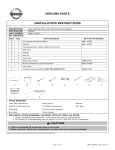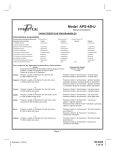Download CA-110 Installation Instructions
Transcript
CA-110 Installation Instructions PROFESSIONAL INSTALLATION STRONGLY RECOMMENDED Installation Precautions: Kit Contents Roll down window to avoid locking keys in vehicle during installation (1) - Control Module Avoid mounting components or routing wires near hot surfaces (1) - Multi Pin Input/Output Harness Avoid mounting components or routing wires near moving parts (1) - IRS-Shock Sensor Tape or loom wires under hood for protection and appearance (1) - Literature Package (2) - 2 Button High Frequency Transmitters (1) -2 Pin Door Lock Harness (1) - Programming Switch (1) - Siren Use grommets when routing wires through metal surfaces Use a voltmeter for testing and verifying circuits Technical Support For Authorized Dealers (800) 421-3209 FCC COMPLIANCE This device complies with Part 15 of the FCC rules and with RSS-210 of Industry Canada. Operation is subject to the following two conditions: 1. This device may not cause harmful interference, and 2. This device must accept any interference received, including any interference that may cause undesired operation. Warning! Changes or modifications not expressly approved by the party responsible for compliance could void the user’s authority to operate the equipment. 128-6832 1 of 16 INSTALLATION OF THE MAJOR COMPONENTS Control Module: Select a mounting location inside the passenger compartment (behind the dash), and secure using the two screws provided. The control module can also be secured in place using cable ties. Be certain that the chosen location will not interfere with the proper operation of the vehicle. Avoid mounting the module to or routing the wiring around the steering shaft/column, as the module or wiring may wrap around or block the steering wheel preventing proper control of the vehicle. Secure the module in the chosen location using cable ties or screws as necessary. Do not mount the module in the engine compartment, as it is not waterproof. Siren: Select a location in the engine compartment that is not accessible from below the vehicle. The selected location must be clear of hot or moving parts within the engine compartment The siren must be pointed downward to prevent water retention and the flared end must be pointed away from and out of the engine compartment for maximum sound distribution. Before securing the siren, check behind your chosen location to assure that the mounting screws will not penetrate any factory wiring or fluid lines. Secure the siren mounting bracket using #8 self taping screws or by first using the mounting bracket as a template, scribe or mark the mounting holes. Drill the marked holes using a 1/8" drill bit, then mount the siren using #8 sheet metal screws. Dash Mounted LED: A small Red LED included in the kit will serve as a visual indicator of the alarm's status. It should be installed in the dash, located where it can be easily seen from outside the vehicle, yet not be distracting to the driver. Once a location has been selected, check behind the panel for wire routing access, and to confirm the drill will not damage any existing components as it passes through the panel. Drill a 1/4" hole, and pass the red and blue wires from the LED through the hole, from the front of the panel. Firmly press the body of LED into the hole until fully seated. Valet/Programming/Hi-Jack Override Switch Select a mounting location that is within reach of the ignition switch, as this switch in combination with the ignition switch, will be used to program the certain features of the system. It is suggested that the switch be mounted to the lower dash panel in the driver's area within reach of the driver. Two Stage IR-s Shock Sensor: Select a solid mounting surface for the shock sensor inside the passenger compartment (behind the dash), and mount the sensor using cable ties, making sure to allow access to the sensitivity adjustment potentiometer for use later in the installation. 2 128-6832 2 of 16 WIRING THE SYSTEM Red: +12 VDC CONSTANT BATTERY SOURCE Connect this wire to a +12 Volt constant source found at the vehicles ignition switch. This wire provides power for the control module. Orange: 300 mA Ground Output When Armed -N.C. Starter Disable This wire is provided to control the starter disable relay. Connect the orange wire to terminal 86 of the relay. Connect relay terminal 85 to an ignition wire in the vehicle that is live when the key is in the ON and CRANK positions, and OFF when the key is in the OFF position. (this is where the pink wire from the alarm should be connected). Cut the low current starter solenoid wire in the vehicle (usually found at the ignition switch), and connect one side of the cut wire to relay terminal 87A. Connect the other side of the cut wire to relay terminal 30. NOTE: This is a normally closed starter disable arrangement, and when power is removed from the system, the starter disable feature will not operate, allowing the vehicle to start. Code Systems does not recommend using the Orange wire to interrupt anything but the starting circuit of the vehicle. White: Parking Light Output (+/- 15 AMP MAX) This wire is provided to flash the vehicle’s parking lights. Connect the white wire to the output side of one of the vehicle’s parking lights. White w/Red: Parking Light Polarity Input This wire is provided as a polarity input of the pulsed parking light output relay. a) For vehicles with positive switching parking lights. Connect the White/Red wire to a +12 VDC constant battery source. b) For vehicles with negative switching parking lights. Connect the White/Red wire to a solid chassis ground source. Black w/Red: Positive Siren Output Route this wire through a rubber grommet in the firewall, and to the siren location. Connect the Black/Red wire to the positive wire of the siren. Secure the black ground wire of the siren to chassis ground. Black: Chassis Ground Connect this wire to a solid, metal part of the vehicle’s chassis. Do not confuse this wire with the thin black antenna wire that exits the control module independently. Tan: Delayed 200 mA Pulsed Output/Channel 2 This wire pulses to ground via an independent RF channel from the keychain transmitter. This is a transistorized, low current output, and should only be used to drive an external relay coil. WARNING: Connecting the Tan wire to the high current switched output of trunk release circuits, and some remote start trigger inputs, will damage the control module. In these cases connect the Tan wire to terminal 86 of a 30A automotive relay, and wire the remaining relay contacts to perform the selected function of channel 2. Brown/Black: 200 mA Horn Output The brown/black wire is provided to beep the vehicle’s horn. This is a transistorized low current output, and should only be connected to the low current ground output from the vehicle’s horn switch. If the vehicle uses a +12 VDC horn switch, then connect the Brown/Black wire to terminal 86 of a relay, and connect relay terminal 85 to a fused +12 VDC battery source. Connect relay terminal 87 to the vehicle’s horn switch output, and connect relay terminal 30 to a fused +12 VDC battery source. 3 128-6832 3 of 16 Grey: (-) Instant Trigger Zone 2 This is an Instant ground trigger wire. It must be connected to the previously installed hood and/or trunk pin switches. Green: Negative Door Trigger Input If the vehicle’s courtesy light switches have a (-) ground output when the door is opened (GM and most Imports), you must connect the Green wire to the negative output from one of the door switches. WARNING: Do not use the green wire if the vehicle has +12 volt output type door switches. (see Purple Wire). Violet: Positive Door Trigger Input If the vehicle’s door courtesy light switches have a +12 volt output when the door is opened (most Ford and some Imports), you must connect the Violet wire to the positive output from one of the door switches. In most cases, the Violet wire will only needs to be connected to one door switch, no matter how many doors the vehicle has. WARNING: Do not use the Violet wire if the vehicle has ground output type door switches. (see Green Wire) Pink: (+) 12 VDC Ignition Source Connect this wire to the ignition wire from the ignition switch. This wire will show +12 volts when the ignition key is turned to the to the ON, RUN and START positions, and will have 0 volts when the key is turned to the OFF and ACCESSORY positions. 2 Pin White Connector: Dash Mounted LED Route the red and blue wires in the 2 pin white connector from the LED to the control module, and plug it into the mating white connector on the side of the module. 2 Pin Red Connector: Valet/Programming/Override Switch Route the 2 pin red connector from the override switch previously mounted to the mating two pin connector on the module. 4 Pin White Connector: IRS-Shock Sensor Harness Route the 4 pin connector from the previously installed shock sensor to the mating 4 pin connector of the module. 4 128-6832 4 of 16 Blue & Green 2 Pin White Connector:Door Lock/Unlock Outputs These wires will provide a pulsed ground output to the factory door lock control relay. The maximum current draw through these outputs must not exceed 300 mA. 3 Wire Ground Switched Door Locks: In this application, the blue wire provides a ground pulse during arming, or the pulsed ground lock output. Connect the red wire to the wire that provides a low current ground signal from the factory door lock switch to the factory door lock control relay. The green wire provides a ground pulse during disarming, or the pulsed ground unlock output. Connect the green wire to the wire that provides a low current ground signal from the factory door unlock switch to the f factory door lock control relay. 3 Wire Positive Switched Door Locks (Relay required see Diagram 1 & 2): Diagram1 Diagram 2 Lock Fused + 12v 86 87 Unlock Fused + 12v 85 86 + 12 Volts 87a 30 85 87 + 12 Volts 87a 30 X X Lock Relay Vehilce CUTInHERE Unlock Relay In Vehilce CUT HERE 5 Wire Alternating 12 Volt (Relay required see Diagram 3 & 4): Diagram 4 Diagram 3 Lock Fused + 12v 86 87 87a 30 Door Lock Switch Unlock Fused + 12v 86 85 + 12 Volts Door Lock Motor 87 87a 30 Unlock Switch 85 + 12 Volts Unlock Motor X X CUT HERE CUT HERE 128-6832 5 of 16 COMPLETING THE INSTALLATION Antenna Wire: Be sure to extend the thin black antenna wire to it’s full length, and cable tie into place where it cannot be damaged. Avoid wrapping this wire around major, high current wire looms. Adjusting the Shock Sensor: Gently turn the adjustment knob counterclockwise to turn down the sensitivity and turn clockwise to turn up sensitivity. Close the hood and trunk lids, and arm the alarm . Wait 6 seconds for the accessories trigger zone to stabilize, then test the sensitivity adjust as needed CAUTION: Never perform this test on the vehicle’s glass, as you may break the window. WARNING ! Setting the sensitivity too high can cause false alarms due to noise vibrations from passing trucks and heavy equipment. To decrease sensitivity, turn the adjustment screw counter clockwise. Wire Dressing: Always wrap the alarm wires in convoluted tubing, or with a spiral wrap of electrical tape. Secure these looms along the routing using cable ties. This will ensure that the alarm wires are not damaged by falling onto hot or sharp moving surfaces in the vehicle. ADDITIONAL INFORMATION: The CA-110 comes programmed with button 1, controlling Arm/Lock & Panic Button 2 operates Disarm/ Unlock and the channel 2 output’s Tan wire. Channel 3, (Both Buttons), of the transmitter controls the Anti Hi-Jack operation when the feature is selected on. Note: The Hijack feature #9 of the module must be selected on to take advantage of this feature. For information consult the feature programming section of this manual. For transmitter programming information, consult the transmitter programming guide 5 128-6832 6 of 16 PROGRAMMING THE TRANSMITTERS The keychain transmitter included with the system have been pre-programmed at the factory, with each button pre-assigned to control a specific function of the system. It is important to remember that during programming, each individual step of the procedure must be executed within 15 seconds of the previous step. When the 15 second time limit is allowed to expire, the system will automatically terminate the programming mode. This is indicated by a long chirp from the siren. Additionally, the system will store codes from up to 4 different transmitters. If a 5th transmitter is programmed to any receiver channel, then the first transmitter programmed to that channel will be erased from the system’s memory. To program new or additional transmitters, the alarm must be disarmed: 1. Enter the vehicle, and turn the ignition key to the ON position. 2. Press and release override/pushbutton 3 times. 3. The dash LED will flash one time, and the sounding device will beep one time, indication the system is ready to accept programming for receiver channel 1. 4. Press and hold the Arm/Disarm Icon button until the sounding device emits a long beep, indicating the signal has been stored into memory. 5. If you have additional transmitters (up to 4) that need to be programmed, repeat step 4 for each transmitter. Programmable Features Select By Operating Transmitter Press Btn 1 Press Btn 2 Press Btns1&2 Siren Indications 1 Chirp 2 Chirps 3 Chirps 1) Arming Method Passive Arm Active Arm 2) Ignition Control Lock/Unlock Off On 3) Passive Or Active Door Locks Active Passive 4) Single Or Double Pulse U/L Single Pulse Double Pulse 5) Door Lock/Unlock Pulse Duration 1 Second 3 Seconds 6) Siren Chirps On/Off On Off 7) Horn Chirps On/Off On Off 8) Passive Rearm From Active State On Off 9) Anti Hi-Jack Feature Off On 10) Horn Chirp Duration 10ms 16ms 30ms Defalut settings are in BOLD 6 128-6832 7 of 16 To program these selectable features; Action Turn ignition on then back off Press and release the valet switch 6 times You are now in programming mode First Second Third Fourth Fifth Sixth Seventh Eighth Ninth Tenth System Response No response 1 Chirp from Siren Press and release the valet switch (1) time BTN 1 = 1 Chirp LED Flashes 1 time BTN 2 = 2 Chirps or Press and release the valet switch (2) times BTN 1 = 1 Chirp LED Flashes 2 times BTN 2 = 2 Chirps or Press and release the valet switch (3) times BTN 1 = 1 Chirp LED Flashes 3 times BTN 2 = 2 Chirps or Press and release the valet switch (4) times BTN 1 = 1 Chirp LED Flashes 4 times BTN 2 = 2 Chirps or Press and release the valet switch (5) times BTN 1 = 1 Chirp LED Flashes 5 times BTN 2 = 2 Chirps or Press and release the valet switch (6) times BTN 1 = 1 Chirp LED Flashes 6 times BTN 2 = 2 Chirps or Press and release the valet switch (7) times BTN 1 = 1 Chirp LED Flashes 7 times BTN 2 = 2 Chirps or Press and release the valet switch (8) times BTN 1 = 1 Chirp LED Flashes 8 times BTN 2 = 2 Chirps or Press and release the valet switch (9) times BTN 1 = 1 Chirp LED Flashes 9 times BTN 2 = 2 Chirps or Press and release the valet switch (10) times BTN 1 = 1 Chirp LED Flashes 10 times BTN 2 = 2 Chirps BTN1& 2 = 3 Chirps Passive Arm Acitve Arm Ignition Locks OFF Active Door Locks Passive Door Locks Single Pulse D/L Double Pulse D/L 1 Sec. Door Locks 3 Sec. Door Locks Siren ON Siren OFF Horn ON Horn OFF Re-Arming ON Re-Arming OFF Anti Hi-Jack OFF Anti Hi-Jack ON Horn Pulse 10mS Horn Pulse 16mS Horn Pulse 30mS Note : Once you enter the feature programming mode, do not allow more than 15 seconds to pass between steps, or the programming will be terminated. 7 128-6832 8 of 16 128-6832 9 of 16 ANTENNA DOOR UNLOCK OUTPUT (-) SHOCK SENSOR L.E.D. (PLUG-IN) DOOR LOCK OUTPUT (-) GREEN BLUE CA-110 5A RED FUSE VALET/OVERRIDE SWITCH PINK VIOLET GREEN GRAY BROWN/BLACK TAN BLACK WHITE/RED ORANGE BLACK/RED WHITE 15A ORANGE FUSE 85 STARTER MOTOR SIDE STARTER KEY SIDE SWITCHED +12VOLTS IGNITION BLACK SWITCHED +12VOLTS IGNITION POSITIVE DOOR TRIGGER INPUT (+) NEGATIVE DOOR TRIGGER INPUT (-) NEGATIVE HOOD/TRUNK TRIGGER (-) HORN OUTPUT (LOW CURRENT (-) CHANNEL 2 OUTPUT (-) CHASSIS GROUND RED PARKING LIGHT POLARITY PARKING LIGHT OUTPUT WHITE RED BLACK 86 87 30 87A +12 VOLTS CONSTANT















